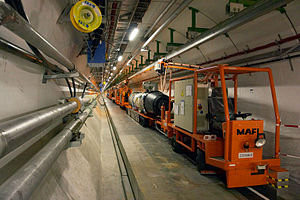Large Electron–Positron Collider

The former LEP tunnel at CERN being filled with magnets for the Large Hadron Collider, a slightly different successor experiment.
|
|
| Intersecting Storage Rings | CERN, 1971–1984 |
|---|---|
| Super Proton Synchrotron | CERN, 1981–1984 |
| ISABELLE | BNL, cancelled in 1983 |
| Tevatron | Fermilab, 1987–2011 |
| Relativistic Heavy Ion Collider | BNL, 2000–present |
| Superconducting Super Collider | Cancelled in 1993 |
| Large Hadron Collider | CERN, 2009–present |
| Future Circular Collider | Proposed |
The Large Electron–Positron Collider (LEP) was one of the largest particle accelerators ever constructed.
It was built at CERN, a multi-national centre for research in nuclear and particle physics near Geneva, Switzerland. LEP collided electrons with positrons at energies that reached 209 GeV. It was a circular collider with a circumference of 27 kilometres built in a tunnel roughly 100 m (300 ft) underground and passing through Switzerland and France. LEP was used from 1989 until 2000. Around 2001 it was dismantled to make way for the LHC, which re-used the LEP tunnel. To date, LEP is the most powerful accelerator of leptons ever built.
LEP was a circular lepton collider – the most powerful such ever built. For context, modern colliders can be generally categorized based on their shape (circular or linear) and on what types of particles they accelerate and collide (leptons or hadrons). Leptons are point particles and are relatively light. Because they are point particles, their collisions are clean and amenable to precise measurements; however, because they are light, the collisions cannot reach the same energy that can be achieved with heavier particles. Hadrons are composite particles (composed of quarks) and are relatively heavy; protons, for example, have a mass 2000 times greater than electrons. Because of their higher mass, they can be accelerated to much higher energies, which is the key to directly observing new particles or interactions that are not predicted by currently accepted theories. However, hadron collisions are very messy (there are often lots of unrelated tracks, for example, and it is not straightforward to determine the energy of the collisions), and therefore more challenging to analyze and less amenable to precision measurements.
The shape of the collider is also important. High energy physics colliders collect particles into bunches, and then collide the bunches together. However, only a very tiny fraction of particles in each bunch actually collide. In circular colliders, these bunches travel around a roughly circular shape in opposite directions and therefore can be collided over and over. This enables a high rate of collisions and facilitates collection of a large amount of data, which is important for precision measurements or for observing very rare decays. However, the energy of the bunches is limited due to losses from synchrotron radiation. In linear colliders, particles move in a straight line and therefore do not suffer from synchrotron radiation, but bunches cannot be re-used and it is therefore more challenging to collect large amounts of data.
...
Wikipedia
